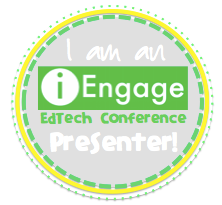Let me start off by saying, the Smekens Education Literacy Retreat was amazing! I learned a great amount in such a short 2-day time frame. The main presenter, Kristina Smekens, is highly knowledgeable. The way she shares information is entertaining and fun, which is always a bonus when sitting for 2-days. If you ever get a chance to attend the retreat, take it! I'm hoping to attend annually, since the topics change each summer. Anyway, in the upcoming weeks, I will be sharing information from the eight sessions I attended. I don't have specific dates of when I'll be posting, since I am supposed to be taking a break from educational-related things (Yeah, right!), but here are the session topics: :)
- Achieving Complex Thinking During Reading
- Executing Complex Tasks After Reading
- Building Stronger Beginnings and Endings
- Teaching Academic Vocabulary with Six Interactive Strategies
- Differentiating to Support English Language Learners
- Inferring Ideas from Visuals & Multimodal Texts
- Revitalizing the Writing Process
- Using Mentor Texts to Teach Sentence Variety
One more thing before I fill you in on the first session. I strongly recommend getting Chart Sense K-2, Chart Sense 3-8 and Chart Sense for Writing written by Rozlyn Linder. I purchased these professional texts last summer and have certainly not regretted it.
I have used Instagram, Twitter, Facebook, Pinterest and this blog to get the word out about these books. The reason I am referencing them is because of their repeated mention at the Literacy Retreat. It seemed as if a high percentage of the mini-lessons discussed at the retreat were taken from these books! Rozlyn Linder, the author of the Chart Sense books, is a genius. There are tons of Reading mini-lessons organized by the standards and each mini-lesson contains useful and extremely easy-to-implement anchor charts. My Chart Sense books have been tabbed, dog-eared and highlighted and are definitely some of my "must-have" resources.
Okay, moving on. There was so much information shared at this session. I will be sharing a few key points, some anchor charts, a fun activity and three online resources mentioned within the session's duration. Here we go! :)
Session 1: Achieving Complex Thinking During Reading
The essential question for this session was based on the image below: How do you get kids to think across the continuum of complex thinking?
When students are asked to read a complex text, they first need to learn how to peel back the layers of a text before digging in. We, as teachers, need to get students to think at different levels starting with the Word Levels and then progressing to the level of Discerning Greater Meaning. As you may already know or have personally encountered within your classroom, students have a hard time with thinking in terms of "the bigger picture", which includes thinking about characters across a text.
The Critical Consideration level is where teachers begin asking students to analyze more deeply about a text. For example, a prompt used at this level may be, What is the character's purpose for doing this? Kristina Smekens mentioned the Critical Consideration level is where teachers often start to lose kids in terms of comprehending a complex text. However, once students are more secure at this level, asking them to begin synthesizing across multiple texts can begin to happen. Synthesizing happens in the Discerning Greater Meaning level. This last level on the continuum is where students are asked to do something with what they learn during reading.
Underneath the continuum, you'll notice DOK Levels, which stand for Depths of Knowledge Levels. Students need to be able to think at a variety of levels. Click here to learn more!
Phase 1 is considered *Simplistic Thinking* where students are asked to recall, draw, list, illustrate, etc. It's important for students to start at this level. As teachers, don't jump into complex thinking questions during the first read! Stick to the standards- R2.1, R2.2, R2.3 and have the students reread a text multiple times. Always ask face-value questions when students first read a text.
Phase 2 is known as *Moderately Complex Thinking* where students are asked to assess, compare, conclude, revise, etc. In this phase, students need to question the author and analyze his/her choices of why certain portions of the text were added, as well as think about figurative and technical meanings, author's purpose, and vocabulary.
Phase 3 is *Complex Thinking*. Students need to apply concepts, analyze, connect, create, critique, prove, etc. during reading. This is the point where students go complex! Teachers need to get students to zoom in on some portions of a text, but zoom out again to synthesize information across multiple texts. For example, students may be asked to look at arguments in various informational books or make text-to-text connections. Teachers may want to give students books on the same topic to compare or books written by the same author or with the same theme.
Anchor charts are known to support students' thinking on more complex levels. Students usually are able to retell what happens in a text, but teachers need to get them to discuss, for instance, how the characters interact with one another, too. They need to be able to track events in sequential order. Start simple by asking students to discuss a particular character: How is the character acting? Then move them onto more complex questions about multiple characters: How are characters interacting with one another? What sort of relationships do they have? Below is the Interaction Tracker used as an example at the retreat. Click on the image to download two available versions.
Students are used to What is the answer? However, the times have changed, as we all know. With the Common Core State Standards, teachers need to ask students What is the answer? Why? What's the evidence to support your thinking? This is a HUGE shift in thinking. Krista Smekens said "Do not be satisfied with students' *right answers* to your questions because they could have been a guess. Instead ask, Where in the text are you getting this?"
Discussions about textual evidence were a strong focus in this session. The retreat attendees were warned to remember: All evidence is a detail, but not all details are evidence! Teachers need to make students become aware of what constitutes as strong evidence. Just because it's in the text doesn't mean it backs up and supports the evidence. Writing details from a text is NOT EVIDENCE, but citing directly from the text IS evidence.
Kristina discussed various mini-lessons to bring back to the classroom. Many of the ideas to get students to achieve complex thinking during reading were directly taken from my favorite Chart Sense books. I used my copies of the books to take pictures of some charts mentioned at the retreat. If you're interested in a viewing a previous post I wrote regarding textual evidence using a few of the charts, click HERE. This post will also lead you to a textual evidence freebie I've created. :)
One of the best highlights about the Literacy Retreat was the giveaways. The attendees were given numerous goodies. One of the goodies was a set of bags called Finding Author Evidence. I love them! I'm looking forward to this activity in the Fall. Even if you don't have a set, any gallon-sized Ziploc Bags will do. You can have your students create their own. :)
For this activity, once students finish reading a text, the teacher should start by providing a claim or inference for the students. Be careful not to start off too complex by having students think up their own claim or inference. As an example, the teacher may state the claim: "I think this character is a bully!" Have students work together in small groups to support the given claim.
Kristina stated that finding textual evidence should be a kinesthetic activity. Students should record text evidence on sentence strips, notebook paper cut into strips, Post-It Notes, or whatever else you can find. They must be able to move sentences around and discuss their reasoning for the evidence with peers. Sorting sentences to prove the claim (ex: the character is a bully) will allow students an opportunity to rank the evidence in order of importance. The discussions with peers is what gets the ideas and learning started. Students need to see others' perspectives! I've provided the corresponding graphic organizer for this activity, if you would like to give it a try with your students, too. Just click on the image to download.
Last, but not least, below are some online resources teachers can use with students in the classroom to develop complex thinking skills. I'm only familiar with Time for Kids, so the other resources are on my list to investigate when school starts again. - VOKI: Have students apply Point Of View in Finish the Story narrative prompts with VOKI. Use this online resource to design an avatar emulating a character. Voices are recorded into a computer and recited back as a character. Fun!
- Time for Kids and ProCon.org are great resources for students to analyze and evaluate arguments. According to Kristina Smekens, students need to learn to distinguish claims versus reasons versus evidence. These online resources were recommended when teaching students how to track an author's claim with his/her reasons and support.













































Great blog - did your admin send you to this conference? I've never heard of it! Sounds like you have lots of take-aways, and I totally want those Chart Sense books!
ReplyDeleteDefinitely get the Chart Sense books! I got a flyer in the mail and asked to attend. My wish was granted. I hope it will become an annual event for me, and hopefully YOU! :)
DeleteAmazing! I am absolutely in love with this post. I am giving a presentation next week to all of our 3rd grade teachers about the DOK chart and how to get kids to ask and answer critical questions. I am ordering the Chart Sense books right now. I can't wait to share that resource with our district. Thank you!
ReplyDeleteHi, Kristi. :) I'm so glad this post is helpful to you! I really love the Chart Sense books. You won't regret the purchase. Thanks for your kind comments and good luck with your presentation. ;)
Delete